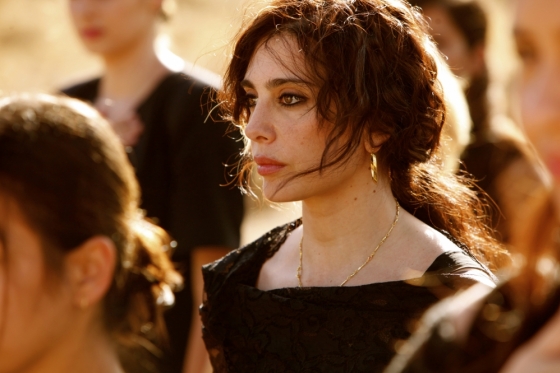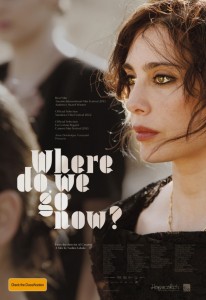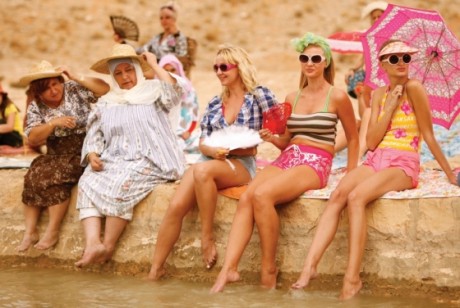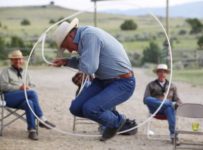The title of the film proves to be incredibly apt in a story that frequent changes tone and direction, from tragedy to a musical number about making hash cookies.
[stextbox id=”grey” caption=”Where Do We Go Now? (2011)” float=”true” align=”right” width=”200″]
Director: Nadine Labaki
Writers: Nadine Labaki, Rodney El Haddad, Jihad Hojeily, Sam Mounier
Runtime: 100 minutes
Starring: Nadine Labaki, Mustapha Sakka, Mustapha El Masri
Distributor: Hopscotch
Country: Lebanon
Rating (?): Worth A Look (★★★)
Nadine Labaki’s debut film Caramel showed audiences a side of Lebanon that they may not have been familiar with, choosing to focus on the everyday entanglements of a group of women who gather at a beauty salon in Beirut. With Where Do We Go Now?, Labaki continues to focus on the role of women in Lebanese society, but is far more direct in her approach to the social and political tensions that have divided a nation. Winner of the Audience Award at the 2011 Toronto Film Festival, wider reactions may be more polarised for a film that often struggles to find its groove.
In a small and isolated Lebanese village, where there is one television that sits in the only spot to get reception, a group of Christians and Muslims live together. Despite the clashes that rage in other parts of the country, the two groups have a mostly peaceful coexistence, at least until a series of misunderstandings push interfaith tensions to their limits. When tragedy strikes, the women of the village must band together around Amale (Nadine Labaki) to stop the men from doing serious harm to one another, using all the means that they have at their disposal.
Shot mostly in Taybeh, a village near Baalbek that contains a church neighbouring a mosque, there is an incredible amount of authenticity to the film. With the exception of Labaki, who both stars in and directs the film, the cast is made up entirely of non-professional actors, interacting with each other in a series of real villages in Lebanon. However, this is contrasted immediately with the hyper-reality of song and dance, which not only serves as the introduction to the women of the village, but is the subject of a major plot point as well. These conflicting tones don’t always sit well, with the film swinging from broad comedy of errors, to tragedy very rapidly, but then just as swiftly back to a musical number. The point might be that the two emotions go hand-in-hand in Lebanon, but from a storytelling point of view, it simply makes for an uneven pace.
The cast of non-professional actors are amazing, however, in capturing these rapid shifts in tone. The capers in the first half of the film are quite amusing, and keeps with Labaki’s idea of exposing a different side of Lebanon to the world. How that same cast deals with some of the heavier emotional moments is just as impressive. Yet a musical number, inspired by the director’s love of musicals and animated films from her childhood, never sits entirely well. In isolation, the sequence is a wonderful piece of cinema, but in an attempt to suspend disbelief in the audience, the same way we would for a fairy tale, Labaki gives us and the cast one tonal change too many, and the genuine parts sometimes get lost in the cacophony.
The title of the film comes from the idea of finding solutions to the problem of perpetual war, only to question what the next step is. This is incredibly important for a nation that has undergone such extensive political turmoil in its history. While the message behind Where Do We Go Now? is an incredibly important one, and it is highly entertaining for much of the film, its lack of focus keeps it from being anything more than the same lightweight diversion depicted in its narrative.
Where Do We Go Now? is released in Australia on 28 June 2012 from Hopscotch.






